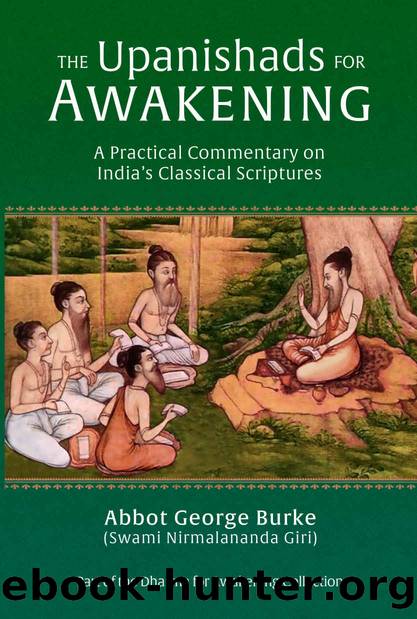The Upanishads for Awakening: A Practical Commentary on India’s Classical Scriptures by Abbot George Burke (Swami Nirmalananda Giri)

Author:Abbot George Burke (Swami Nirmalananda Giri) [Burke (Swami Nirmalananda Giri), Abbot George]
Language: eng
Format: azw3
Publisher: Light of the Spirit Press
Published: 2019-07-08T16:00:00+00:00
There are two selves that drink the fruit of Karma in the world of good deeds. Both are lodged in the secret place [of the heart], the chief seat of the Supreme. The knowers of Brahman speak of them as shade and light. (1.3.1)
There are two kinds of Selfs, the many individual Selfs and the one Universal Self. The Mundaka Upanishad likens them to two birds of the same appearance who sit in the same tree. “Two birds, companions [who are] always united, cling to the Self-same tree. Of these two, the one eats the sweet fruit and the other looks on without eating” (Mundaka Upanishad 3.1.1).
First we come to know the individual Self, and that enables us to attain the knowledge of the all-inclusive Supreme Self. How the two exist as one yet two is incomprehensible to the intellect but is readily experienced by the inmost consciousness of the persevering yogi. Yet intellectually we need to have some grasp of the unity/duality, otherwise we can have no correct perspective on anything, inner or outer. Extreme dualism is an error, and monism of any kind is even worse in its simplistic nature. For this reason the enlightened use the expression non-dual (advaita) as the nearest we can come to conveying the truth of our existence.
The verse beginning Purnamadah purnamidam is usually interpreted as a statement that the Relative has come from the Transcendent while retaining essential unity with the Transcendent. But it can also be understood as referring to the individual Self that exists rooted in the Universal Self. It, the Atman, originates in the Supreme Self, the Paramatman, and is never separate from that Self. If examined, the two will be seen to be one. How is it possible? The One alone knows–and those who have united their consciousness with the One through yoga.
In the heart of our consciousness (not the physical heart) the sages say there is the Chidakasha, Conscious Space or Ether also called the Hridayakasha, the Space/Ether of the Heart. There the individual Self and the Supreme Self dwell together. It is also known as the cave of the heart.
It is easy to understand that the individual Self abides in (and as) the heart (hridaya), but when we look at the vast manifestation of cosmic life that is the creation it is natural for our awareness to be drawn outward and thereby forget that the Supreme Self is right there inside in the same space (akasha). The Paramatman is not in the cave of our heart only incidentally, since It is everywhere, but that is Its abode, its native place, Its center. Its manifestation can be found everywhere, but It can be found only in the cave of the heart. How foolish to climb mountains, delve into the earth, wander across the plains, or cross the seas, thinking to find the abode of God which is in the heart alone.
There are those who know Brahman directly and those who possess a secondary knowledge based on intuition resulting from their seeking of Brahman.
Download
This site does not store any files on its server. We only index and link to content provided by other sites. Please contact the content providers to delete copyright contents if any and email us, we'll remove relevant links or contents immediately.
| Bhagavad Gita | Upanishads |
| Vedas |
Fingersmith by Sarah Waters(2017)
Kundalini by Gopi Krishna(1827)
The Bhagavad Gita by Bibek Debroy(1668)
Indian Mythology by Devdutt Pattanaik(1626)
Wheels of Life by Anodea Judith(1612)
The Yoga of Jesus: Understanding the Hidden Teachings of the Gospels by Paramahansa Yogananda(1532)
The Man from the Egg by Sudha Murty(1502)
Autobiography of a Yogi (Complete Edition) by Yogananda Paramahansa(1489)
Chakra Mantra Magick by Kadmon Baal(1388)
The Book of Secrets: 112 Meditations to Discover the Mystery Within by Osho(1357)
Avatar of Night by Tal Brooke(1258)
The Sparsholt Affair by Alan Hollinghurst(1246)
Sparks of Divinity by B. K. S. Iyengar(1230)
Karma-Yoga and Bhakti-Yoga by Swami Vivekananda(1222)
The Bhagavad Gita (Classics of Indian Spirituality) by Eknath Easwaran(1208)
Gandhi by Ramachandra Guha(1197)
The Spiritual Teaching of Ramana Maharshi by Ramana Maharshi(1175)
Skanda Purana (Great Epics of India: Puranas Book 13) by Bibek Debroy & Dipavali Debroy(1140)
Hinduism: A Very Short Introduction (Very Short Introductions) by Knott Kim(1122)
